Healthy sleep hygiene refers to the different habits and practices that are necessary for good nighttime sleep and daytime alertness.
Good night time sleep not only ensures physical and mental health but also improves one’s productivity and overall quality of life. The most important sleep practice is to spend the recommended number of hours asleep; they shouldn’t be too little or too many.
Sleep requirements vary depending on age, lifestyle, and health. Adults need seven to nine hours of sleep while kids (school-going children) require nine to eleven hours.
Recently, many people finding it difficult to sleep. Stress, depression, and bad eating habits disrupt the regular sleeping routine.
Taking a few glasses of alcohol before sleeping, for example, may have a drowsy effect in the first few hours.
However, the sleep-inducing effect wears off, leaving your mind alert. Research shows that alcohol stimulates regions of the brain that are responsible for cognitive functions, resulting in light sleep.
As the alcohol’s starts wearing off, sleep is disrupted, and REM (rapid eye movement) sleep increases. This article will showcase the best hygiene tips for a healthier bedtime routine.
1) Create a Bedtime Schedule

Image Source: https://commons.wikimedia.org/wiki/File:Sleeping-girl.jpg
Our bodies react to routines even in matters of slumber. Also known as the circadian rhythm, it allows the body to fall asleep and wake up in the morning.
Being consistent about the time you hit the sack and wake up even during weekends improves quality of sleep and alertness during the day.
You can improve the circadian rhythm by turning off all electronic gadgets. The radiation emitted by these devices and energy-efficient bulbs is known as the blue light, and it affects the body’s ability to wind down and fall asleep. Napping during the day also disrupts your bedtime sleep-wake cycle.
Most people take naps in the afternoon after a heavy lunch. They should be as short as fifteen to twenty minutes; longer naps may deprive you of sleep later on.
If you still can’t fall asleep twenty minutes after turning in, wake up and engage in a relaxing activity. Tossing and turning only trains the brain to remain awake during the night.
2) Use the Right Kind of Pillow

Image Source: https://commons.wikimedia.org/wiki/File:Pick_The_Right_Edmonton_Pillow.jpg
Pillows affect the quality of your sleep and how well your body rests. Using the wrong pillow can exacerbate pre-existing conditions like neck pain, headaches, and arm numbness.
The most common pillows are the latex and memory foam pillows as they provide additional support for the neck. They also reduce pressure points by adjusting the shape of the body throughout the night.
If you have an allergy, you may garner on a few easy ways to deodorize your memory foam pillow to keep it clean.
The primary goal of using a pillow is to ensure a neutral alignment of the head and the body. As such, individuals should select pillows based on their sleeping patterns.
People who sleep on their backs should use thin pillows while side sleepers require firm pillows to compensate for the distance between the ears and shoulders.
3) Make Appropriate Dietary Choices

While having heavy meals before bedtime disrupts sleep, eating tiny amount of food also wrecks the body’s sleep pattern. Experts recommend eating dinner in the evening, say 7 p.m., to allow ample time for digestion.
If you’re still feeling hungry before bedtime, take a light snack to stimulate the production of minerals and vitamins that are responsible for sleep. Typically, four vitamins and minerals are considered sleep enhancers:
- Magnesium
- Tryptophan
- Calcium
- B6
Tryptophan is primarily responsible for promoting sleep as it is converted to melatonin hormone, which regulates circadian rhythm.
Eating fruits like cherries that are rich in melatonin aids in falling asleep. Bananas are rich in magnesium and vitamin B6, while a glass of low-fat yogurt is laced with calcium. Eating small portions of snacks that are rich in these minerals before bedtime promotes a healthy sleep routine.
4) Create a Sleep-friendly Environment

The bedroom should have a relaxed ambiance. There is a strong association between the bedroom and the mood.
Creating a sleep-friendly environment involves paying attention to the five senses; sight, smell, taste, touch, and sound.
As such, you will want to dim the lights an hour before bedtime to jumpstart that part of the brain that activates sleep. You may also use dark-shaded curtains to keep the room dark.
Soothing scents like lavender reduce heart rate, blood pressure, and improve your mood, thus helping you relax before bedtime. When it comes to taste, it depends on the foods you eat before going to sleep; they should stimulate sleep as discussed earlier.
Touch plays a significant role in your sleep routine. Be sure to select bedding that feels good on your skin and help regulate temperature. Materials like wool, linen, silk, and cotton are natural and have breathable fibers.
Reduce noise in your bedroom by using a sound conditioner. It creates a soothing backdrop that is consistent throughout the night. You may also use earplugs to rid of noise from within the house. Be sure to switch off the TV as changing tones and volumes significantly reduce the quality of sleep.
5) Wind Down Source

Winding down creates a healthy bedtime routine. It not only allows your body to relax but also to have an uninterrupted sleep throughout the night. There are lots of ways to wind down:
- Have a warm bath before going to bed. It allows the body to reach a temperature that is ideal for a good night’s sleep.
- Perform a few relaxation exercises like light yoga stretches to relax body muscles. Engaging in rigorous activities has a negative effect.
- Reading a book also helps both mind and body to relax. You may also listen to relaxation CDs. They may have gentle hypnotic music, a narrated script, and sound effects that soothe the senses and stimulate sleep.
- Write to-do-lists for the following day. It helps organize your thoughts and rids of any distractions.
Real Life Example
The Real Slim Shady, popularly known as Eminem, confessed about his sleeping problems in 2006 during an interview for Complex Magazine. He relied on sleeping pills most of the time to fall asleep until he checked into a rehab for help.
Today, Eminem appreciates the need of dimming lights in a bedroom for quality sleep. He is said to demand complete darkness when sleeping. As such, he seals the windows and doors of the bedroom with aluminum foil prevent light from entering the room.
Conclusion
Evidently, developing good sleep hygiene is not just about sleeping the recommended number of hours. It calls for sticking to a regimen that improves the quality of sleep throughout the night and helping the body relax.
